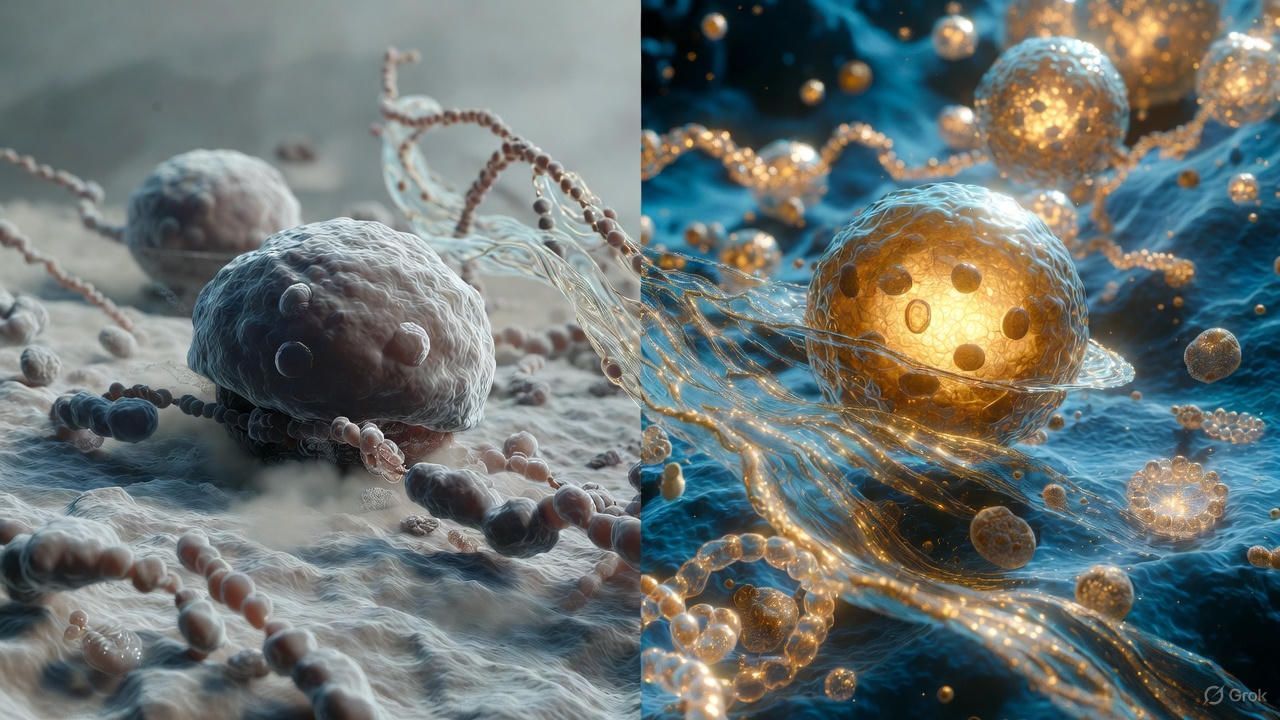Peptide Therapy
Understanding Peptide Therapy
What is Peptide Therapy?
Peptide therapy is a cutting-edge medical treatment that uses specific chains of amino acids—known as peptides—to target and regulate various functions within the body. These peptides act as signaling molecules, instructing cells to perform specific actions such as healing, regeneration, or hormone production.
How It Works
As we age, the natural production of peptides in our bodies begins to decline, which can lead to symptoms such as fatigue, weight gain, reduced immune function, and slower recovery from injury. Peptide therapy replenishes and optimizes these essential compounds, helping you restore balance and function at the cellular level.

Unlocking the Science: What Are Peptides?

At the molecular level, peptides are short chains of amino acids—typically between 2 and 50—linked by peptide bonds. Think of them as miniature proteins with highly specific roles, functioning as biological messengers, enzyme regulators, and hormone precursors. Their compact size gives them a unique advantage: they can interact with cells and receptors more directly and selectively than larger proteins.
The Diversity of Peptide Types
Peptides vary widely in structure and function. Here’s a quick breakdown:
- Signal peptides: These direct cellular machinery, guiding proteins to their destinations within or outside the cell.
- Neuropeptides: Found in the brain and nervous system, they influence mood, pain, appetite, and cognitive function.
- Hormonal peptides: Insulin and glucagon fall into this group, regulating blood sugar levels and metabolic activity.
- Antimicrobial peptides: These peptides, such as defensins, naturally defend the body by disrupting bacterial and fungal membranes.
Built by the Body, Powered by Nature
Your cells manufacture peptides through transcription and translation, using genetic code as a blueprint. They act fast, relaying signals from one cell to another with precision. For example, growth hormone-releasing hormone (GHRH) signals the pituitary gland to release human growth hormone (HGH), which then triggers tissue growth and metabolic regulation. This molecular communication orchestrates countless physiological functions—healing, immune modulation, and hormone regulation among them.
Why Synthetic Peptides Enter the Conversation
Biotechnologists replicate and modify naturally occurring peptides to create synthetic versions with enhanced stability, longer half-lives, or targeted effects. In clinical settings, these lab-designed peptides serve specific therapeutic goals. For instance:
- BPC-157: A synthetic peptide that accelerates tissue repair, especially in muscles, tendons, and ligaments.
- Thymosin alpha-1: Enhances immune response by stimulating T-cell activity, often used in antiviral therapies.
- Melanotan II: Influences skin pigmentation but also demonstrated effects on libido and fat metabolism.
Synthetic peptides bridge the gap when the body’s own peptide production declines or when targeted intervention is required. Their precision and potent bioactivity make them ideal for therapeutic applications in age management, recovery, and metabolic health.
How Peptide Therapy Works in the Body and in Modern Medicine
A Targeted Tool in Functional and Regenerative Medicine
Peptide therapy uses specific amino acid sequences to signal and stimulate precise biological pathways. It's not a one-size-fits-all approach—it's a tightly focused strategy that falls under the umbrella of functional and regenerative medicine. Rather than just masking symptoms, peptide therapy addresses underlying imbalances at the cellular level.
In clinical settings, peptides are prescribed to support regeneration, balance hormone levels, restore biochemical signals, or enhance physiological function. Whether the end goal is improved healing, hormone modulation, or metabolic optimization, peptides interface directly with cellular receptors to initiate change.

Delivery Methods: More Than Just a Needle
Injectables remain the most bioavailable route, particularly subcutaneous injections, which release peptides gradually into systemic circulation. This method allows precise dosing and timing, which is critical for peptides that have short half-lives or require targeted peaks.
However, not every peptide must be delivered via injection. Depending on molecular structure and stability, some formulas come as:
- Topical creams or gels – used for localized effects on joints or skin, especially in cosmetic and injury-related treatments.
- Nasal sprays – a good alternative for peptides that cross the blood-brain barrier, such as those targeting cognitive function.
- Oral tablets or troches – suitable for a limited number of peptides that resist breakdown by stomach acid.
Selection of the administration route depends on the peptide's bioavailability, desired effect, and patient preference. A peptide like BPC-157, known for tissue repair, is typically injected, while melatonin-stimulating peptides may come in nasal form.
Customized Protocols Based on Individual Biology
No two peptide therapy plans look the same. Dosages, delivery, and combinations are customized based on diagnostic panels, hormone profiles, and symptom patterns. Healthcare providers often run bloodwork, saliva tests, or urine analyses before starting a regimen. For instance, a patient with low IGF-1, high cortisol, and disrupted sleep-wake cycles might benefit from a specific combination of growth hormone-releasing peptides (GHRPs) and circadian-modulating compounds.
Safety and Supervision Make the Difference
Under medical supervision, peptide therapy has demonstrated a strong safety profile. The key variable is regulation—peptides sourced through licensed compounding pharmacies meet rigorous standards for sterility, purity, and potency. When administered based on clinical diagnostics and monitored through follow-up, peptides can produce measurable improvements without the risks tied to synthetic hormones or unsupervised supplementation.
Anti-Aging Benefits of Peptide Therapy

Stimulates Growth Hormone and Collagen Production
Peptide therapy directly influences the anterior pituitary gland to increase natural growth hormone (GH) secretion. Among the most studied peptides for this are CJC-1295 and Ipamorelin. When these are administered in targeted sequences, they trigger pulsatile GH release that mimics the body’s youthful patterns. This increase in GH elevates the production of insulin-like growth factor 1 (IGF-1), which promotes cellular repair, tissue regeneration, and lean body mass accrual.
On the surface—literally—peptides ignite collagen synthesis by activating fibroblasts in the dermis. A clinical evaluation published in the Journal of Cosmetic Dermatology (2020) highlighted that signaling peptides such as Matrixyl (palmitoyl pentapeptide) led to a statistically significant increase in dermal thickness and skin smoothness after just 12 weeks of consistent use. Results documented improved elasticity and reduced wrinkle depth in participants between ages 45 and 65.
Reduces Oxidative Stress and Cellular Degeneration
Cellular aging accelerates when oxidative stress remains unchecked. Thymosin Beta-4 and Epitalon are two peptides that intervene at this biological inflection point. Epitalon, in particular, upregulates telomerase activity—an enzyme responsible for elongating telomeres, the protective caps at the ends of chromosomes. A Russian research study spanning over 12 years recorded extended lifespan and improved organ function among subjects regularly administered Epitalon.
Meanwhile, antioxidants alone can’t match the cumulative protective effect of mitochondrial-targeting peptides like SS-31. This synthetic compound penetrates mitochondrial membranes, stabilizing cardiolipin and minimizing free radical leakage during energy metabolism. The result: improved cellular efficiency and delayed signs of senescence across muscle, cardiac, and neural tissue.
Boosts Energy, Skin Vitality, and Cognitive Function
Aging drains more than just outward appearance—it slowly erodes stamina, clarity, and drive. Certain peptides, by restoring hormonal balance and activating mitochondrial output, counteract this decline. MOTS-c, a mitochondrial-derived peptide, deserves mention here. Clinical observation shows that it enhances metabolic homeostasis and increases energy production by activating AMP-activated protein kinase (AMPK).
The impact extends to the brain. Cerebrolysin, a neuropeptide formulation used in European regenerative practices, shows neuroprotective properties. According to a longitudinal analysis published in Drugs & Aging (2015), patients over 60 treated with Cerebrolysin displayed notable improvements in memory retention, attention span, and executive functioning compared to placebo groups.
Skin likewise responds to this cascade of rejuvenation. Peptides such as GHK-Cu, a copper-binding tripeptide, restore skin density, reduce discoloration, and accelerate wound healing. Histological analysis reveals that treated tissue contains new blood vessel growth, increased capillary circulation, and restructured extracellular matrix—all hallmarks of younger biological skin.
- Increased GH and IGF-1: Promotes muscle tone, tissue repair, and natural fat metabolism.
- Improved mitochondrial output: Enhances daily energy, focus, and physical resilience.
- Revitalized skin architecture: Triggers dermal remodeling through fibroblast stimulation.
- Neuroprotective action: Supports synaptic plasticity and reduces cognitive fatigue.
- Cellular longevity: Slows aging at the chromosomal level through telomerase activation.
Ask yourself this: If aging is built into biology, why not influence the process from within? Peptide therapy doesn't just slow down the clock—it recalibrates the mechanism altogether.
What Conditions Can It Help?
Peptide therapy has shown promise in a wide range of applications, including:
Hormone optimization – improving energy, mood, and libido
- Weight management – supporting metabolism and fat loss
- Injury recovery – accelerating tissue repair and reducing inflammation
- Immune support – enhancing the body’s natural defenses
- Anti-aging – promoting skin elasticity and cognitive health
Personalized & Monitored Treatment
Every peptide therapy protocol is personalized based on your health goals, medical history, and lab results. Treatment is administered under medical supervision to ensure safety, effectiveness, and the best possible outcomes for your unique needs.
Peptide therapy represents a modern approach to proactive health and wellness—helping you feel, function, and live better.
Empower Your Health Journey

Unlocking Longevity with Peptides
As an experienced biohacker, I apply meticulous scientific analysis and thorough personal testing to learn more about the intricate and multifaceted world of peptides. By taking a hands-on approach, I strive to uncover the myriad ways in which these bioactive compounds can enhance health and well-being.
My carefully crafted suggestions, grounded in extensive research, offer reliable, practical insights that you can confidently implement. By effectively combining peer-reviewed data with real-world outcomes, I aim to empower you with the knowledge and tools needed to optimize your health journey.
Why Peptides Are the Future of Anti-Aging
Peptides interact with your body's natural systems, unlike harsh medications or artificial hormones. They are highly effective, precise, and remarkably safe when used properly.
Over the past five years, I have personally tested dozens of peptides, carefully tracking their effects on everything from body composition and cognitive function to sleep quality and recovery time.
The Art and Science of Peptide Protocols
Elevate Your Wellness Journey With The Inside Project Biohacking Newsletter
Timing, dosing, cycling, and combining peptides require both scientific understanding and practical experience. In my peptide guide, I share:
- Exact protocols I've used with detailed dosing schedules
- How to source high-quality peptides safely
- Potential side effects and how to minimize them
- Biomarkers to track your progress
- Advanced combination strategies for specific goals
Real Stories, Real Results
"After starting peptide therapy, I noticed a significant improvement in my energy levels and recovery time. I used to struggle with fatigue after workouts, but now I feel revitalized and ready to tackle my day. It's been a game-changer for my overall health!"
Sarah Thompson, Fitness Enthusiast

